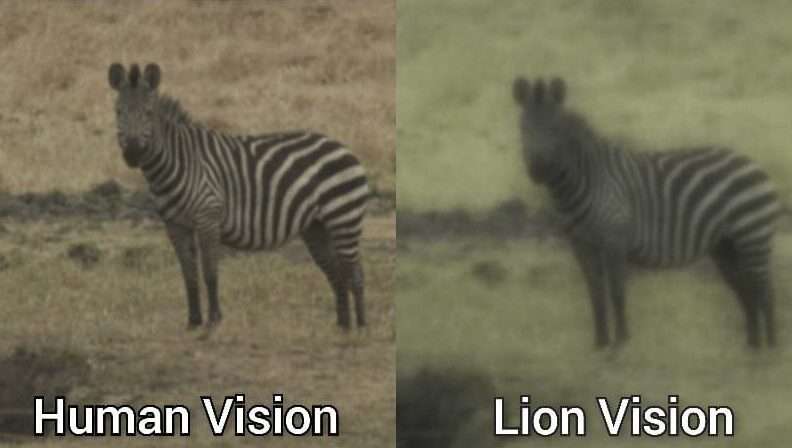Lions are the large predatory cats of the species Panthera leo. According to the International Union for Conservation of Nature (IUCN), they are vulnerable animals native to Africa and India. Lions are also said to be the “The King of the Jungle.” So, have you ever wondered how lions see the world, or are they colorblind?
The answer to the question, “Are Lions colorblind,” is: Lions are not completely colorblind. They are dichromats and can see the various color shades combined with blue and green hues. Due to being dichromatic, lions perceive large wavelength colors like orange and red in grayish shades. They see the world predominately in blue, green, yellow, and gray shades.
Based on color recognition, lion vision is different than human vision. Later in this post, we have explained all details about lion vision and how they see the world. So, without wasting anime, let’s discuss.
What Colors do Lions see?
Lions can see numerous color variations with the combination of blue and green hues. Lions are dichromatic animals; it means the cones in their eyes can only perceive small (blue) and medium (green) wavelength colors.
They are only colorblind to red hue. In contrast, humans are trichromatic means the cones in our eyes are sensitive to blue, green, and red colors.
At best, lions can see various color shades ranging from 428 nm (blue) to 539 nm (yellow). They primarily see the world in blue, yellow, and grayish shades.
Due to the lack of cone for sensing prominent wavelength colors, lions can perceive color variation from blue to green and differentiate orange-red hues into shades of gray to yellow.
Like many wild animals, lions’ eyes are also focused on the rods rather than the cones. Cones in the retina of eyes help to perceive different kinds of hues, whereas rods in the eyes assist in sensing the brightness of the light, or we can say black and white vision. Their eyes have more rods than cones that help them perceive clearly in low-light conditions.
Major difference-

Human eyes have a predominance of cones. Therefore, we can recognize millions of color shades ranging from 400 to 720 nm wavelength. However, humans cannot see anything clearly in dark or low light conditions.
On the other hand, lion eyes have a predominance of rods that helps them to see much better in the low light environment. Rods capture even the slightest of light and enhance the vision with more brightness. But in exchange, lions cannot recognize colors the same as humans.
Can Lions see in the Dark? Are Lions nocturnal?
Lions are nocturnal animals and can see much better than humans in the dark. Like other nocturnal animals, they have tapetum lucidum, a thin reflective membrane in their eyes that directly reflects even the slightest visible light from the outside onto the retina for more excellent absorption.

Not only this, but they also have more rods density than cones in their eye receptors. Hence, more rods along with tapetum lucidum help lions to see and hunt at night.
Lions mostly hunt during the night and rest during the daytime. Also, they are often active at dawn and dusk because the surroundings predominately comprise blue color shades.
However, most of their prey also share the same vision. For example– deer are also dichromatic and can see best during dawn and dusk. To read more on deer’s vision, visit the article below.
Must Read- Can Deer see Color (Deer Color Vision Explained)
Note: Even nocturnal animals like lions cannot see in the complete darkness. Yes, it’s true they at least need low-light emission such as from the moon to wander at night.
How do Lions see the world?
Lions have good eyesight and see the world primarily in blue, yellow, and gray shades. They have a clear vision and visually glimpse the world with clarity and details but not as much as humans. Like all big cats, lions’ most essential senses are vision, smell, and hearing.
Below we have inserted the image of how lions see the world.

As justified in the image, lions witness mostly in yellow and green shades and with clarity but not much as humans. They recognize red, orange, and other large wavelength colors in grayish shades. They have binocular vision, which means their eyesight is more focused on details than the field of view. Humans also have binocular vision. It signifies that, like humans, lions can also focus the far entities with clarity.
Also, there is no research to prove that lions can see ultraviolet or infrared lights. They recognize the colors mostly from 428 nm to 539 nm wavelength.
How far can Lions see?
Lions have an excellent vision and can see clearly up to eight times as far as humans can with details. They can easily spot and focus their prey at a distance of more than two miles.
Not only this, but they can also easily identify and recognize small animals like rabbits or baby deer from a far distance in the tall grasses. But remember, in terms of clarity and focus, humans have better eyesight than lions.
Their eyes can concentrate on a particular entity; however, we can see a wide range of far environments with details. Lions have evolved their eyesight in such a way they can easily identify their prey in the tall grasses, whereas humans have evolved their eyes to perceive our surroundings better with colors and details.
Lion vision vs Human vision
| Lion Vision | Human Vision |
| Lions have dichromatic vision. | Humans have trichromatic vision. |
| Are sensitive towards blue and green colors. | Are sensitive towards blue, green and red colors. |
| Can see in the dark. | Cannot see in the dark. |
Here, we conclude our article on “Are Lions Colorblind and what colors do lions see,” along with other relevant queries. We hope you like it. Below we have shared some common knowledge about Mountain Lions. So, let’s read it.
All about Mountain Lions-
Mountain Lions, also known as cougars, are large cats from subfamily Felinae that are found all over America. They are ambush predators who normally hunt deer and rodents. They are the fourth-largest cat species that are up to 7ft long.
Mountain lions also share the same dichromatic vision as lions. Below are some common queries regarding mountain lions.
Q1. Are mountain lions nocturnal?
Ans. Yes, like other wild animals, mountain lions are also nocturnal. They also have tapetum lucidum in their eyes that allow them to see in the dark.
Q2. Do mountain lions attack humans?
Ans. Normally Mountain Lions avoid humans, but they are wild predators; if they sense any danger from us, they will attack.
Q3. What to do if you encounter a mountain lion?
Ans. Do not run or show any fear; it will stimulate the mountain lion’s instinct to chase. Instead of running, stand still, wave up your arms and shout in a loud voice. By looking bigger, scare the mountain lion off.
Note- This information is only an overview. Kindly read the official safety tips and guidelines before going on any outdoor adventure.
Your Safety in Mountain Lion Habitat by National Park Service official site.
References-
Zebra Stripes through the Eyes of Their Predators, Zebras, and Humans by PLOS ONE
Also Read
Most Dangerous Nocturnal Animals
What Colors can Horses see?
Rarest Snakes in the World

Meet Monty, the visionary founder of How It See, being an engineering student, he’s fueled by an insatiable curiosity about the world around him. He is captivated by an eclectic correlation between animal groups, science, and nature, and this fascination drives his quest for understanding.
After completing his degree, he’s set on a mission to delve deep into the realm of nature, accumulating knowledge to share with you through his writing. In the meantime, he loves to watch anime and read anime.

